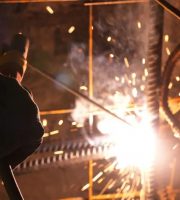1. The center support of high-rise steel structures should adopt forms such as X-shaped diagonal bars, single diagonal bars, herringbone diagonal bars, V-shaped diagonal bars, etc..
2. When high-rise steel structures use single diagonal braces that can only withstand tension, it is necessary to set two symmetrical sets of single diagonal braces at two corresponding spans, and ensure that the cross-sectional area of diagonal braces in different directions in each floor is not more than 10% different from the horizontal projection area, to ensure that the structure has roughly the same lateral force resistance in both directions..
3. The K-shaped support system of high-rise steel structures may experience significant lateral deformation due to the buckling of compression diagonal members or the yield surface of tension diagonal members under seismic action, resulting in buckling of the middle part of the column under lateral force. Therefore, seismic fortification structures cannot be supported by K-shaped diagonal bars..
4. The axis of the central support diagonal bar should, in principle, intersect at the intersection of the axis of the frame beam and column. If there are difficulties, the distance between the axis of the diagonal bar and the intersection of the axis of the beam and column should not exceed the cross-sectional width of the diagonal bar..
5. The middle node of the herringbone and V-shaped support requires the axis of the diagonal bar in both directions to intersect with the axis of the beam..
6. The support arranged vertically should be extended to the foundation in the form of shear walls below the ground level..
7. In seismic fortification structures, the connection between the two ends of the diagonal braces and the frame beams and columns needs to be rigidly connected in construction..
8. For structures with seismic fortifications of 8 degrees or above, it is advisable to use center supports with energy dissipation devices. At this time, the bearing capacity of the supporting diagonal rod should be 1.5 times the bearing capacity when the energy dissipation device yields or slides..



